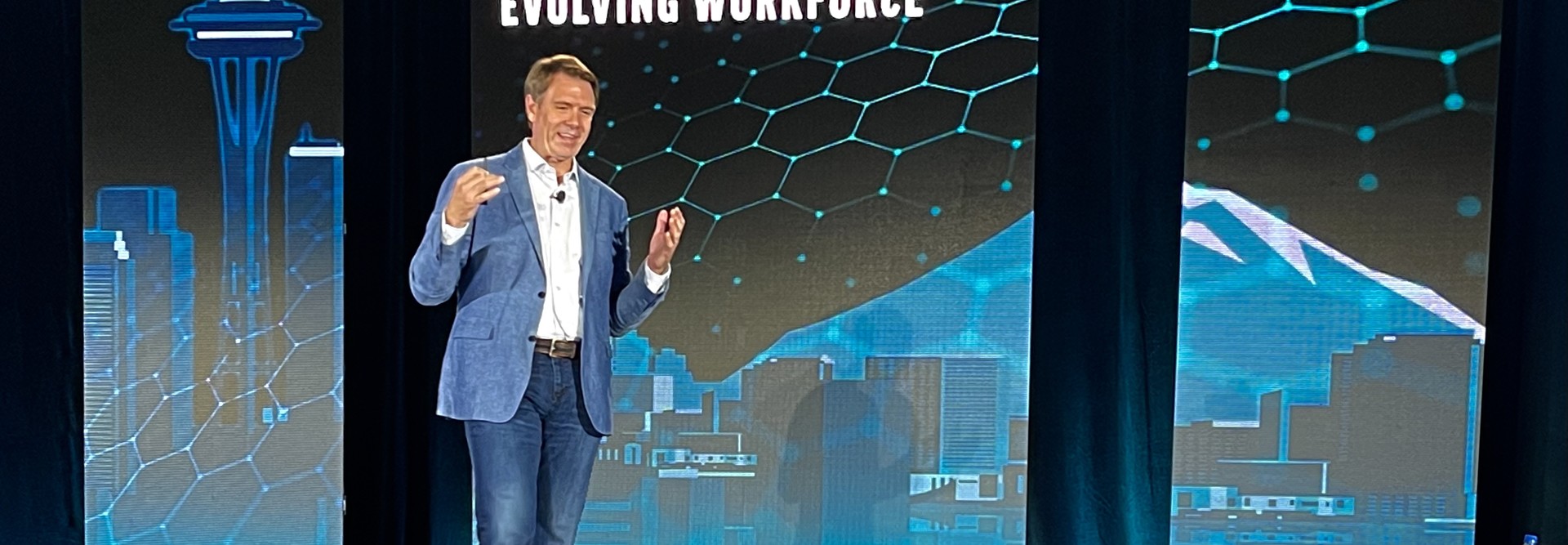The pandemic was a generational event that changed many things, for the good and the bad. One of the positive changes ushered in by the pandemic was the way technology transformed how companies and employees operate.
At the CDW Executive SummIT: Managing the Evolving Workforce in Seattle, held Aug. 10-12, Steven Darrah, director of national solution providers at Intel, presented a session on what technology changes mean for the future of work. Darrah, who has been with Intel for 20 years, said, “We ask, what if? What if you had this technology, what business problem could you solve? How could you transform your business?”
He then told a story about a large retailer he worked with 10 years ago. The retailer was experiencing difficulty managing its inventory, not knowing what was on the shelves at any given time. Darrah joked with the CTO and recommended having a drone fly through the store or a robot go up and down the aisles taking pictures of everything on the shelves. He suggested that the drones would provide the company with a near real-time analysis of what it had in stock. Ultimately, the company didn’t use drones, but Intel did pilot some robots to help. Fast forward to three years ago — just before the pandemic started — when Darrah was attending the National Retail Federation’s trade show, and the first thing he saw was robots with cameras scanning shelves.
LEARN MORE! Read how cutting-edge technology from Intel can help transform your organization.
“By asking that what-if question, that provided an idea of, maybe this can be done,” said Darrah. Asking this as a technologist is really impactful, he added.
As a more recent example of the “what if” approach, Darrah looked at popularity of virtual backgrounds. When the use of virtual backgrounds first started in the early days of the pandemic, people liked that they could be on a work call and pretend they were at the beach instead of at home. It might have been a cheesy idea, but it led people to ask, “what if.” As the use of this technology evolved, with filters that can make us look like we are in an office, it enhanced our ability to work anywhere, at any time. “It was fascinating to see something that was this stupid gimmick at its onset turn it into something that literally enabled the new workforce that we were in,” said Darrah.
Click the banner below to receive exclusive industry content when you register as an Insider.


What Forces Drive Technological Change?
Darrah said that change is driven by one of two things: incredible technology that creates a clear benefit, or a unique event that forces us to adapt. These events don’t happen often, but the pandemic was one of those times, Darrah said. As an example of technology that drives a clear benefit, he cites the rollout of wireless computers. The first computer with Wi-Fi came out in 2001, and it made so much sense to be able to connect to the internet without cables. “There was such a clear benefit that, within one year, 99 percent of all PCs had Wi-Fi because it was so clear,” he said.
Another example Darrah gave of technology driving change was the Ultrabook. When Apple came out with its iPad, it created a new classification of devices, and it quickly became apparent that users’ highest priority was portability. To capitalize on this, Darrah said, “we started a program to drive these engineering specs, and within three years, we took a laptop from a 7 pound behemoth to under 3 pounds.”
When you combine a technology with a clear benefit and a unique event like a pandemic, you see a once-in-a-lifetime inflection point, he said. “In a year and a half, the pandemic drove as much as seven years of transformation.” IT became the most important thing to most companies during the pandemic, he added.
Because of this, the use of videoconferencing increased exponentially. “I can’t communicate with people without seeing their face,” said Darrah. “It drives me nuts when people don’t turn their camera on. I don’t know what you’re saying.”
During the pandemic, 1.28 billion students were required to participate in e-learning. “CDW is our largest partner in selling Chromebooks, and the millions they sold across the country helped schools transform to remote learning overnight,” he said.
We ask, what if? What if you had this technology, what business problem could you solve? How could you transform your business?”
Steven Darrah
Director of National Solution Providers, Intel
How Must the Workspace Continue to Evolve?
After explaining the two factors that drive change, Darrah walked through the three foundational technology pillars that Intel focuses on for navigating the future of work:
- Switching between home and office and solving “last mile” problems
Employees are no longer going to work just in the office or just at home, so organizations need to be able to provide an experience that allows the hybrid worker to plug in and plug out. Darrah notes that employers must make sure the setups are the same in the office and at home, and that it needs to be as simple as plugging in to have access to same number of monitors and other peripherals as what’s available in the office. Darrah warns about connectivity issues with internet providers. “How do we solve for the last-mile connectivity?” he asked.
Intel Evo is the next iteration of the Ultrabook, and it solves many of these issues. Evo includes Thunderbolt to help with reliable connectivity and fast charging, Bluetooth to help pair devices to the user’s computer, and Wi-Fi 6 to reduce latency and improve throughput.
- Proactive and predictive IT
The next thing to consider, Darrah said, is how to support a hybrid work environment: “In the past, everyone was in the office. You had a problem at your desk or with your PC, you take it down to the IT support desk.” We now need tools at the edge that are cloud-based and provide server-like manageability, he added.
- Responding to attacks
“Ransomware and cryptojack are stealthy,” said Darrah. “They operate almost unnoticed.” But these types of hacks are becoming more prevalent, he noted. Intel has rolled out Threat Detection Technology, a suite of applications driving by artificial intelligence and an anomaly-based engine that sits on the physical hardware and operates below the OS, allowing security providers to see if a system has been infected. The technology supplements anti-virus protections, Darrah added.
Find BizTech’s full coverage of the event here. Whether you’re attending the CDW Executive SummIT in person or online, follow us on Twitter at @BizTechMagazine, and join the conversation using hashtag #JoinCDW.


Photography by Joe Kuehne














